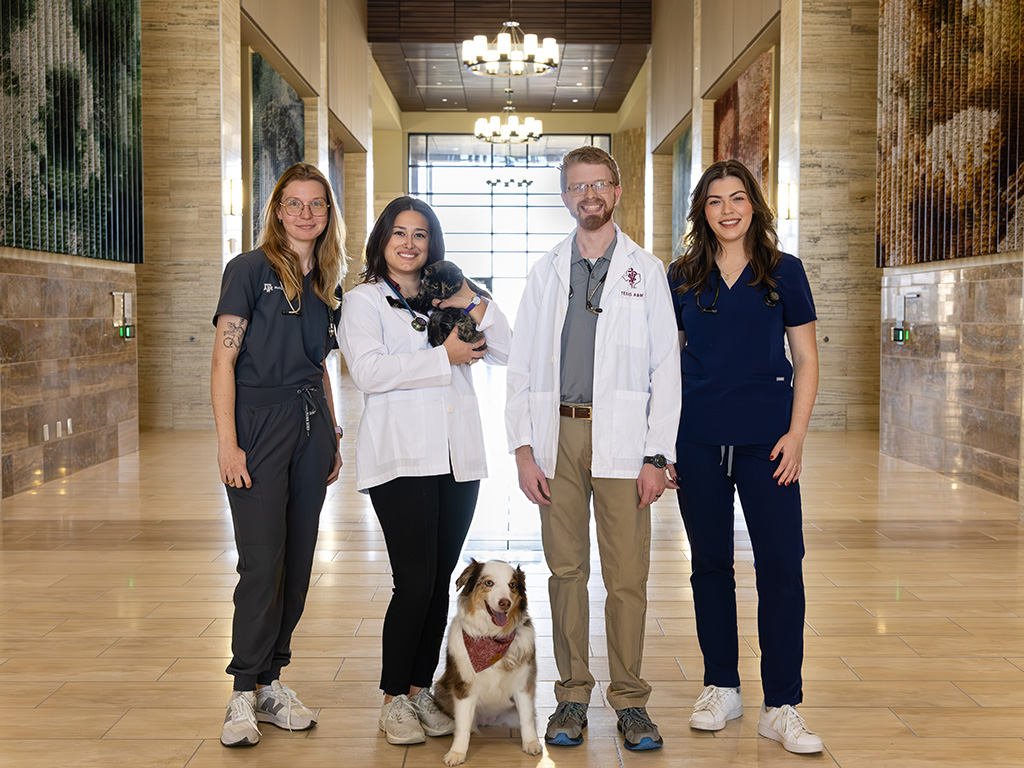Texas A&M Celebrates Its First Cohort Of Dual Veterinary Medicine, Public Health & Epidemiology Graduates
Story by Megan Bennett, VMBS Marketing & Communications

The Texas A&M College of Veterinary Medicine & Biomedical Sciences (VMBS) celebrated the graduation of its inaugural cohort of the Master of Science in Veterinary Public Health & Epidemiology (VPHE) and Doctor of Veterinary Medicine (DVM) Combination Degree Program during the May 2025 commencement season.
As VPHE-DVM graduates, the cohort of four participated in two commencement ceremonies — on Wednesday, May 7, for their DVM degrees and on Saturday, May 10, for their VPHE master’s degrees.
The inaugural cohort of VPHE-DVM students includes:
- Dr. Luke Gibson, from Corpus Christi, Texas, who plans to work in small animal general practice before transitioning to a career in zoonotic disease control.
- Dr. Molly Guyette, from Florida, who will be joining a small animal hospital in St. Louis that works closely with a local animal shelter.
- Dr. Kaitlin Thompson, from Flower Mound, Texas, who plans to work in small animal general practice before pursuing additional training through the Centers for Disease Control and Prevention.
- Dr. Lindsey Walker, from Wimberley, Texas, who will be joining Apollo Veterinary, a small animal practice in south Austin.
The VMBS launched the combination degree program in 2021 in response to the growing need for scientists trained both in veterinary medicine and public health to serve as leaders in their communities and around the world.
“Many years of planning went into program development, with the curriculum designed to develop and support the unique veterinary public health interests of each of our students,” said Dr. Christine Budke, a VMBS professor and interim VIBS department head.
“The five epidemiology faculty members in the Department of Veterinary Integrative Biosciences who act as primary mentors to combination program students are excited to see this first cohort of students graduate,” she said. “We look forward to our graduates becoming leaders who improve the lives of both animals and people.”
The VPHE-DVM degree program trains students to integrate knowledge from both disciplines into their veterinary careers or advance to careers in local, state, federal, and international public health agencies and academia.
“Everyone who goes into veterinary medicine has a different interest, and it was unique to spend time with three other people who were also interested in public health,” Gibson said. “I learned more than I ever thought I would through the VPHE program. From mathematical modeling to parasites and wildlife to learning how to set up a bird net in the courtyard with Dr. Sarah Hamer, it opened my eyes to a lot of different things.”
The program allows students to enroll in graduate courses during the summers, leading to concurrent graduation with both degrees in four years. The VPHE coursework also culminates in a unique capstone project that allows each student to explore a subject relating to his or her career goals.
“My capstone was developing a feline infectious disease guide for cattery or shelter use that summarized the potential of diseases spreading between cats or from cats to people,” Guyette said. “I loved that we had the ability to tailor it to what we wanted to get out of the program. That way the experience was our own and as fulfilling as we wanted it to be.”
The VPHE-DVM degree program offers students the unique chance to build relationships with VPHE faculty, including Budke, Hamer, Keri Norman, Martial Ndeffo, and Gizem Levent.
“Building and using those connections to get more immersed into public health and epidemiology has been really valuable, and I don’t think I would’ve gotten that if I hadn’t done the VPHE program,” Thompson said. “Having this opportunity while I was in veterinary school meant that I was always engaged in thinking about public health and epidemiology during my veterinary courses. The dual program also took off a lot of financial strain, compared to if I had gone back to school to do a master’s degree.”
The program is valuable even for students who don’t plan to pursue a traditional public health career because it emphasizes how veterinarians can contribute to making the world a safer place for people and animals.
“Having a foundation of public health training just makes me a stronger veterinarian,” Walker said. “I am better prepared to support shelter medicine and can better manage diseases and parasites that could spread to other animals or people. Having gone through this program also opens up other doors as to what I could do with my degree and career in the future.”
###
For more information about the Texas A&M College of Veterinary Medicine & Biomedical Sciences, please visit our website at vetmed.tamu.edu or join us on Facebook, Instagram, and Twitter.
Contact Information: Jennifer Gauntt, Director of VMBS Communications, Texas A&M College of Veterinary Medicine & Biomedical Sciences, jgauntt@cvm.tamu.edu, 979-862-4216
You May Also Like








